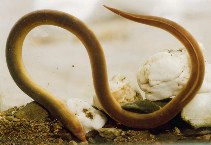| Family: |
Moringuidae (Worm or spaghetti eels) |
| Max. size: |
47 cm TL (male/unsexed) |
| Environment: |
reef-associated; brackish; marine; depth range 3 - 20 m |
| Distribution: |
Indo-West Pacific: East Africa to Samoa, north to the Ryukyus, south to the southern Great Barrier Reef. |
| Diagnosis: |
Vertebrae: 105-113. Body depth 36-51 times the total length (TL) . Head length 10-15 times TL. Dorsal and anal fins continuous with caudal, clearly behind the anus. Distances from snout to dorsal origin, from snout to anal origin and from snout to anus are 75%, 69% and 67% of TL, respectively. Small pectoral fins. 63 pores along the lateral line from head to anus. Adults all brown on the back and lighter on the belly; juveniles have an orange-yellow back and a bluish belly. Specimens in the rivers can reach 47 cm TL (Ref. 57749). |
| Biology: |
Occurs in estuaries and lower parts of the rivers at juvenile and immature adult stages in slow-running waters on sandy bottoms. Mature females stay on shallow marine bottoms; males are pelagic. Reproduction occurs offshore. Leptocephali migrate to the littoral to follow up with their growth. Feeds on fish and invertebrates, especially crustaceans (Ref. 57749). |
| IUCN Red List Status: |
Data deficient (DD); Date assessed: 12 November 2019 Ref. (130435)
|
| Threat to humans: |
harmless |
| Country info: |
In range Ref. 5501. Also Ref. 48613. |
Source and more info: www.fishbase.org. For personal, classroom, and other internal use only. Not for publication.

